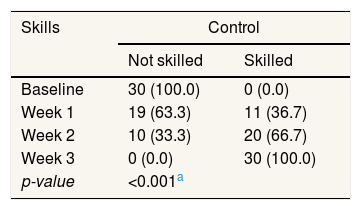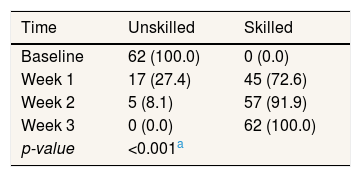
The 3rd International Nursing and Health Sciences Students and Health Care Professionals Conference (INHSP)
Más datosThis study aims to analyze the effectiveness of learning media based on Augmented Reality (AR) on improving the physical examination skills of the urinary system of pregnant women.
MethodThis type of research is an experimental study with a quasi-experimental non-equivalent control group design conducted in January–February 2020 at the Midwifery Polytechnic Laboratory of the Ministry of Health Gorontalo. A sample of 92 students was selected by purposive sampling and met the inclusion criteria. Then the sample was divided into two groups: a control group that was given material through lecture and demonstration methods totaling 30 respondents and an intervention group that was given material through AR learning media and a method of demonstration totaling 62 respondents. Data collection was performed using a checklist to assess student skills improvement. Data were analyzed using the Cochran test to determine differences in skills over time.
ResultsThere was an increase in skills in the control and intervention groups with a statistically significant P<0.001 (P<0.05). However, the results showed that the mean improvement in skills in the week I of the study in the intervention group who were given AR learning media was higher in the percentage of skill improvement (72.6%) when compared to the control group who were given the lecture method and the demonstration method (36.7%). Likewise, the mean increase in skills in week II of the study in the intervention group was higher in the percentage of skill improvement (91.9%) compared to the control group given the lecture and demonstration method (66.7%), although in the third week all respondents in the control group and group the intervention becomes skilled at carrying out a physical examination of the urinary system of pregnant women.
ConclusionAR media is more effective in improving student skills.
Pregnancy is a natural event that every woman will indeed feel. Pregnancy involves several physiological and psychological changes. Physiological changes that occur in pregnant women are the body's adaptation to pregnancy. One example of physiological changes in pregnant women is a change in the urinary system.1–4 This change causes pregnant women to experience discomfort due to increased frequency of urination.
Increased frequency of urination, as a result of increased blood volume, will make the kidneys produce more urine during pregnancy so that it can affect the occurrence of pressure on the bladder, which will cause pregnant women to urinate frequently. This discomfort is normal as long as it does not interfere with the daily activities of pregnant women. Conversely, if the discomfort has begun to overdo and interfere with the activities of pregnant women, causing health problems, certainly not normal anymore.2,5,6
Urinary Tract Infection (UTI) in pregnancy is a common clinical problem in the urinary system of pregnant women due to the many anatomic and physiological changes experienced. UTI is symptomatic (with symptoms) or asymptomatic (without symptoms). UTIs in pregnant women if left untreated can lead to complications such as hypertension, pre-eclampsia, anemia, urosepsis, pyelonephritis, bacteremia, toxic septicemia, thrombosis, phlebitis, chorioamnionitis, abortion, intrauterine growth retardation (IUGR), premature labor, severe septicemia, thrombosis, phlebitis, chorioamnionitis, abortion, intrauterine growth retardation (IUGR), premature labor, severe septicemia, thrombosis, phlebitis, chorioamnionitis, abortion, intrauterine growth retardation (IUGR), premature labor, severe baby septicemia, thrombosis, phlebitis, chorioamnionitis, abortion, intrauterine growth retardation (IUGR), premature labor, severe baby septicemia low (LBW), and neonatal death (stillbirth). It can also cause severe kidney damage that can cause kidney hypertension and kidney failure. UTI is reported to affect 20% of pregnant women and is a major cause of pregnant women getting treatment in obstetric rooms.7–11
The importance of increasing the knowledge and skills of students about the physical examination of the urinary system of pregnant women is one of the methods used to recognize abnormal signs in the urinary system of pregnant women so that it can help prevent and reduce the incidence of morbidity and death of pregnant women and fetuses. Therefore, it is essential to design new and attractive learning media for students following technological advancements that can arouse students’ feelings, thoughts, attention, and willingness to learn and practice skills.
Augmented Reality (AR) technology is a learning media resulting from integrating real objects and virtual objects. AR combines 2D and or 3D virtual objects into a real environment then the virtual objects are projected into real-time. The information displayed through virtual objects cannot be received by users using the five senses. This is why AR is used to interact and perceive users in the real world.12–14 Through AR learning media, it is expected to attract students’ interest and motivation in improving skills, especially physical examination of the urinary system of pregnant women, to produce skilled and competent students.
MethodThis type of research is an experimental study with a quasi-experimental non-equivalent control group design. The population is all Level II Semester III DIII Midwifery Poltekkes Ministry of Health Gorontalo students. The sampling technique used purposive sampling and met the inclusion criteria, namely students who passed the anatomy and KDK II courses, students who were registered as active students, and students who had android devices.
Then the sample was divided into two groups: the control group who were given material through lecture and demonstration methods totaling 30 respondents, and the intervention group provided material through AR-based learning media and the method of demonstration totaling 62 respondents.
Research siteThis research was conducted in January-February 2020 in the Midwifery Laboratory of the Polytechnic of the Ministry of Health, Gorontalo, and has received a recommendation on ethics approval with protocol number 13121908217.
Data types and sourcesData collected from the sample are research variable data (student skills scores). The data was taken based on student data and pure graduation score sheets on implementing the OSCA examination for the physical examination of pregnant women in midwifery level II semester III Poltekkes Kemenkes Gorontalo.
Data collection techniqueThe research variables were collected using a checklist through direct observation to assess respondents’ initial skills in the control and intervention groups. Furthermore, the study began with the delivery of material through lecture and demonstration methods in the control group and continued with the posttest given from time to time, namely in the first week, second week, and third week. Subsequent research was conducted giving material through AR-based learning media and demonstration methods in the intervention group and continued with posttest administration conducted from time to time, namely in the first week, second week, and third week. This research lasted for 42 days.
ResultsThe analysis showed that the control group had a statistically significant difference in P<0.001 (P<0.05) between each measurement. When the initial measurement (pretest) showed 100% of respondents were unskilled. The first week after giving lectures and demonstrations, 36.7% of skilled respondents increased. After giving lectures and demonstrations, week II showed an increase in skills by 66.7% of respondents became skilled. The third week after giving lectures and demonstrations showed that 100% of respondents became skilled in carrying out a physical examination of the urinary system of pregnant women (Table 1).
Differences in respondent skills in control group (n=30).
| Skills | Control | |
|---|---|---|
| Not skilled | Skilled | |
| Baseline | 30 (100.0) | 0 (0.0) |
| Week 1 | 19 (63.3) | 11 (36.7) |
| Week 2 | 10 (33.3) | 20 (66.7) |
| Week 3 | 0 (0.0) | 30 (100.0) |
| p-value | <0.001a | |
The analysis showed that the intervention group had statistically significant differences in skills P<0.001 (P<0.05) between each measurement. The initial measurement (pretest) showed that 100% of respondents were unskilled. After AR giving and demonstration, there was a rapid increase in skills, namely 72.6% of skilled respondents. After giving and the demonstration s, the second week. In week III after AR administration and demonstration showed that 100% of respondents become skilled in conducting a physical examination of the urinary system of pregnant women (Table 2).
Differences in respondent skills in intervention groups (n=62).
| Time | Unskilled | Skilled |
|---|---|---|
| Baseline | 62 (100.0) | 0 (0.0) |
| Week 1 | 17 (27.4) | 45 (72.6) |
| Week 2 | 5 (8.1) | 57 (91.9) |
| Week 3 | 0 (0.0) | 62 (100.0) |
| p-value | <0.001a | |
Provision of AR learning media and demonstration methods in the intervention group more quickly improved the physical examination skills of the urinary system of pregnant women when compared to the control group given lecture and demonstration methods. However, both the control group and the intervention group had significant skills improvement (P<0.05) over time (Tables 1 and 2).
The more often we repeat and hone skills, the more often we store files in the subconscious mind. So without realizing it or not, someone will easily repeat the skills that have been obtained so that it can produce skilled and competent respondents. This is in line with research that states that every learning activity carried out repeatedly and continuously will become a permanent and automatic learning habit so that the final results of the learning process objectives can be achieved optimally.15
In line with this, previous studies have proven that the mean score in filling out questionnaires in the experimental group using AR technology has a higher value than the control group using conventional methods. Similarly, in performing an inferior alveolar nerve block (IANB) anesthesia procedure, the experimental group spent a shorter average of 50.0±14.3s than the control group, 68.4±25.5s. In addition, the experimental group also had a greater anesthetic success rate of 90.9% than the control group of 73.7%.16
Likewise, research that proves that the combination of direct learning and real learning through AR media can create science learning experiences that are superior to conventional learning can affect students’ mastery of concepts.17 As for other studies that show that student learning outcomes in the experimental group using AR media are higher when compared to the control group using non AR media. This comparison is seen in the aspect of knowledge. The average value of knowledge in the control group was only 70.65, while in the experimental group, it reached 80.06.18
AR has proven potential in creating more active, effective, and meaningful learning processes. This is caused by the sophistication of technology that allows students to interact using a series of images that have been designed into the form of software that results from a combination of the real world and the virtual world that can be run through computers or Android mobile devices. Thus providing an exciting and memorable experience for learners and can increase understanding of concepts uniquely without relying on text.19,20
AR plays a role in supporting the learning process in the classroom and outside the classroom, wherever and whenever using a mobile device such as a smartphone or Android.21 Through smartphones that have been activated with AR technology can provide a new and different learning experience for students,22 so AR can help students become active, think creatively and critically in learning.23
ConclusionThis study indicates an increase in the skills of respondents in the control group and the intervention group significantly, with a value of P<0.001 (P<0.05). However, the average skill improvement in the intervention group using AR learning media was better when compared to the control group who did not use AR learning media. AR can be used as an additional reference and consideration in supporting learning media in the learning process in the Laboratory, in the classroom, and outside the classroom to facilitate students learning anywhere and anytime to achieve learning success.
Conflicts of interestThe authors declare no conflict of interest.
Peer-review under responsibility of the scientific committee of the 3rd International Nursing, Health Science Students & Health Care Professionals Conference. Full-text and the content of it is under responsibility of authors of the article.















